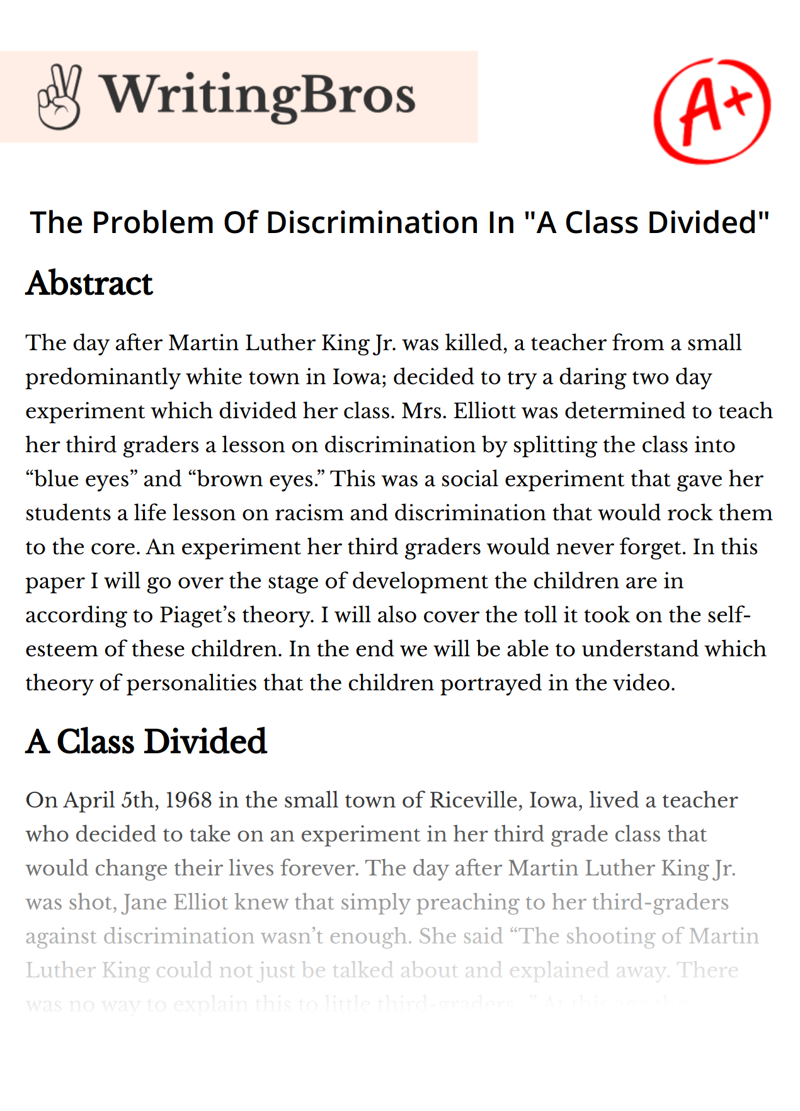The Problem Of Discrimination In "A Class Divided"

Table of contents
Abstract
The day after Martin Luther King Jr. was killed, a teacher from a small predominantly white town in Iowa; decided to try a daring two day experiment which divided her class. Mrs. Elliott was determined to teach her third graders a lesson on discrimination by splitting the class into “blue eyes” and “brown eyes.” This was a social experiment that gave her students a life lesson on racism and discrimination that would rock them to the core. An experiment her third graders would never forget. In this paper I will go over the stage of development the children are in according to Piaget’s theory. I will also cover the toll it took on the self-esteem of these children. In the end we will be able to understand which theory of personalities that the children portrayed in the video.
A Class Divided
On April 5th, 1968 in the small town of Riceville, Iowa, lived a teacher who decided to take on an experiment in her third grade class that would change their lives forever. The day after Martin Luther King Jr. was shot, Jane Elliot knew that simply preaching to her third-graders against discrimination wasn’t enough. She said “The shooting of Martin Luther King could not just be talked about and explained away. There was no way to explain this to little third-graders…” At this age the children are at the concrete operational stage in Piaget’s theory. The children are thinking and answering logically. For example when Mrs. Elliot asked her students “What is brotherhood?” The children responded with “the golden rule” and also said “it’s about treating everyone like they’re your brother.” She then asked her students: “Is there anyone in this United Stated that we don’t treat as our brothers?” The children answered black people and the Indians. This experiment is a great way to teach the children because they get to experience it first hand and live through it as though they were of another skin color.
The Experiment
On day one, the students were told that blued-eyed people are better than brown-eyed people. Mrs. Elliott, communicated to them that brown-eyed people must wear collars so people could tell who had brown eyes. She expressed to her students that brown-eyed people are slower, dumber, bad listeners, and that they didn’t know how to behave. The brown-eyed students were instructed not to drink out of the water fountain and must drink out of paper cups so they wouldn’t infect the blue-eyed students. Mrs. Elliot was stunned at how fast her third-graders changed. “I watched wonderful, thoughtful children, turn into nasty, vicious, discriminating little third-graders.” Self fulfilling prophecy took place as bullying from the blue-eyed children, along with a violent punch to the gut of a brown-eyed boy to a blue-eyed boy after being teased about his eyes. The following day, a blue-eyed boy “forgot his glasses” (maybe he felt he was superior so wanted to show off his blue-eyes), only to find out that the roles were going to be reversed. On the second day of the experiment, brown-eyed people were declared superior to the blue-eyed people. On both days of the experiment, Mrs. Elliott used phonic cards on both groups. On day one, the superior blue-eyed children went through the cards in about half the time the brown-eyed children did. On the second day, the opposite effect occurred, where the brown-eyed children went through the cards faster and the blue-eyed.
What was learned?
At the end of the day, the kids took off their collars off and shared what they experienced in a group discussion. One child said “you can’t judge people based on their skin color, or eye color or whatever physical feature.” Another one said “It doesn’t matter what’s on the outside.” The children learned that they can’t understand what it’s like to be somebody else until they’ve walked in their shoes. Jane Elliot found that after the experiment was completed, the children’s performance academically improved. The children had gained confidence. Seeing first had that it doesn’t matter what you look like as long as you are confident in yourself you can achieve anything.
What can be taken from the documentary?
Discrimination is an idea fabricated in peoples’ minds, creating actual blockades that are tough to overcome. When looking back at the experiment performed on the adults, the blue-eyed individuals argued back to Elliot’s attack on their behavior, making the individuals seem rude. In reality, it was only the situations that were placed upon them. When we think about qualities some might consider those of 'a typical African-American' (baggy clothes, ignorant behavior and language), we are automatically associating the color of a person's skin with these qualities. We see unruly behavior as “evidence,” for instance when the blue-eyed adults argued with Elliot when being attacked for their behavior. That was portrayed as “evidence” for the brown-eyed adults that blue-eyed folks are rude.
Conclusion
Lawrence Kohlberg’s theory that people pass through a series of stages in evolution of their sense of justice and reasoning they use to make moral judgments is the is the best explanation for the behavior of the students in this video. Preconvetional morality blue eyes are superior = (Rewards) browneyes are inferior = (punishment). In the end the children were able to see what it was like to be in someone else’s shoes, they learned that discrimination was wrong and that lesson stuck with them all the way into adulthood.
Cite this Essay
To export a reference to this article please select a referencing style below

